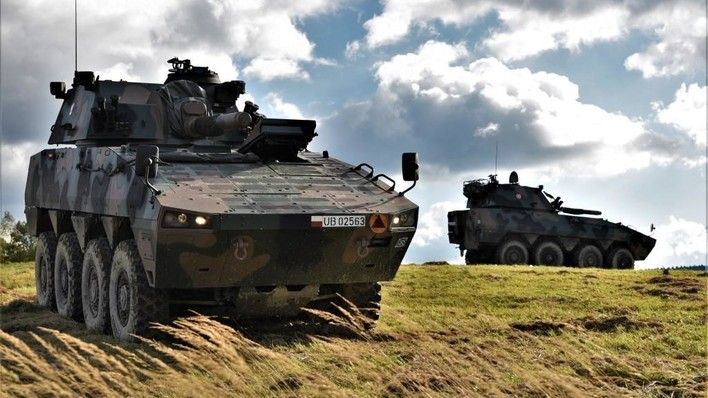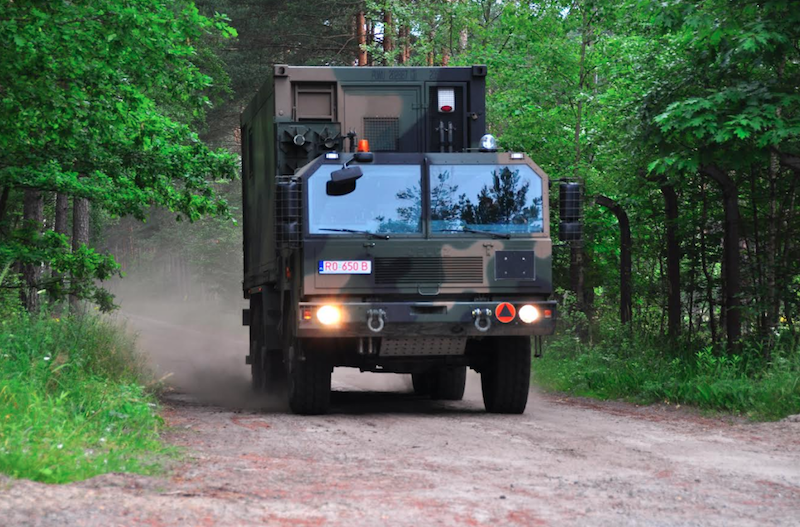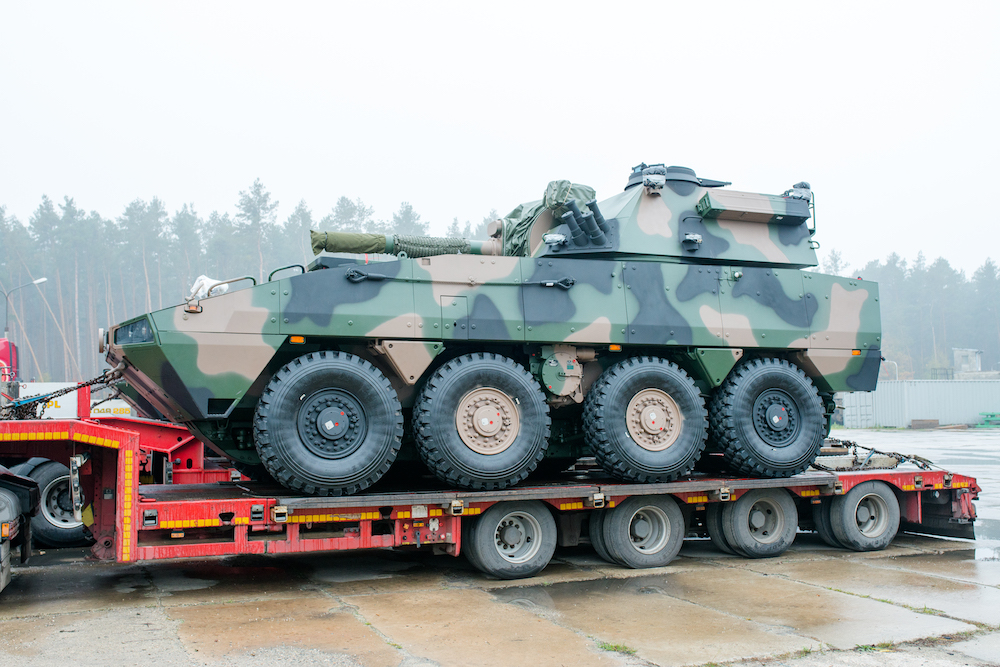Fortieth of the Rak Mortars in Service

HSW has finalized delivery of the elements of the fifth company-level fire module unit (KMO) consisting of the 120 mm Rak self-propelled mortars, based on the wheeled Rosomak platform. The vehicles have been handed off for use in the Polish military. In this way, the quantity of such platforms operated by the Polish Armed Forces went up to 40.
The fifth company-level module was sent to Przemyśl which is a home of the Brig. General Andrzej Galica 5th Highland Battalion, also working closely together with the LITPOLUKRBRIG element. The battalion in question is a part of the 21st Highland Brigade that has already received one company-level Rak mortars module unit back in August. The aforesaid module is stationed at the Rzeszów garrison, more accurately speaking: it is operated by the Brig. general. Józef Kustroń 1st Highland Battalion. The 21st Highland Brigade is the first formation of the Polish military operating two Rak modules already. This means that the brigade currently has the strongest support assets at its disposal, offering combat capabilities as such. Beforehand, Rak mortars had also been delivered to the 17th Mechanized Brigade stationed in Międzyrzecz, 12th Mechanized Brigade stationed in Szczecin and to the 15th Mechanized Brigade stationed in Giżycko.
A unit that is stationed at a base which is located close to the Poland’s eastern border, which is also easternmost NATO base, is the latest user of the Rak system. The 21st Brigade’s area of responsibility includes a peculiarly shaped terrain located in the area where Polish, Ukrainian and Slovakian borders come together. The region is undulating or even mountainous, with numerous forests and terrain and water obstacles. It includes, for instance, the Bieszczady mountain range, or the region in which the Solina-Myczkowce water reservoir is located. In conditions as such, SMK120 Rak-class system has become an important element of fire support assets that remain at disposal of the mechanized elements. Systems of this class make it possible to effectively act against targets that are not visible or that are protected by terrain. Mortars as such are also useful in dynamic maneuver operational context, especially in tough terrain. The fact that the 21st Highland Brigade receives a boost of its operational capability in this form may be interpreted as a spectacular proof of serious attitude the MoD adopts, with regards to formation of a new, 18th Mechanized Division. This large unit is to include the “Highland” brigade.
Delivery of 8 SMK120 Rak mortars and 4 AWD artillery command vehicles (based on the very same Rosomak APC platform) constitutes yet another phase of implementation of the agreement concluded back in April 2016. The 1 billion zlotys worth contract assumes that 8 company fire modules with Rak mortars would be delivered. Each of the modules includes 8 automatic self-propelled mortars and 4 command vehicles (commander’s vehicle, reserve vehicle for the commander’s deputy, and one command vehicle for each of the battery commanders - 2 battery commanders work in a single module). Following the conclusion of the aforesaid contract towards the end of 2017, the MoD also signed an agreement with HSW, concerning the delivery of AWRU recovery/repair vehicles, equipped with a special toolkit the purpose of which is to carry out testing, repairs and maintenance of the mortar’s system in field conditions. These vehicles are based upon the 6×6 Jelcz P662.D35 truck. They are a part of the company-level fire module as another component of the unit, with a single AWRU platform belonging to each of the support elements.
Delivery of another 3 KMO units needs to be completed so that the provisions of the agreement signed 2.5 years ago are fully complied with. This delivery is scheduled to happen in 2019. As we have found out at HSW S.A. and what could have been observed in the manufacturing departments, we should not worry - the deadlines will be met.
This is yet another important day for us, as a manufacturer. According to the Agreement signed in April 2016, we are handing off the third company-level fire unit for further use by the Polish Military, without any delays. We are working on this contract which is very important for us, also being one of the most significant contracts signed within the Polish defence industry. We are handing off the equipment in line with the agreement, without any delays. The contract in question is defining a path of positive changes that would happen at our company
During the upcoming weeks, it is also expected that agreements will be signed with regards to delivery of Artillery Ammunition Carriers (AWA) that are to become a complement to the already delivered Rak KMO units. Naturally, this platform is also going to become a part of the inventory of the further Rak mortar elements. The matter related to development of artillery reconnaissance vehicle for the Rak units is also getting mature. As the originally suggested platform did not meet the requirements, the concept has been changed and ultimately the reconnaissance vehicle will be based on the Rosomak APC. The vehicle is to offer satisfactory performance and higher level of comfort for the crew (larger interior). It will also diminish the number of types of carriers that form the composition of the Rak modules. If solution as such is used, solely Rosomak (SMK120, AWD and AWR) and Jelcz (AWA and AWRU) vehicles would be included in the modules. This is especially important from the point of view of logistics and technical/maintenance support required during the operations undertaken by the unit.
Agreement concerning the AWR vehicle is expected to be concluded by the end of the year, while a prototype, configured in a new manner, shall be presented and handed off for a test programme next year. Until the contracts are signed with regards to both of the aforesaid components (AWA and AWR), neither the delivery schedule nor the value of the agreements can be disclosed.


Finalization of work concerning the contract signed back in April 2016 means that a situation may emerge, in which, a year after the delivery of 64 mortars, 32 command vehicles and 8 AWRU platforms, the HSW facility would suffer from a gap in the manufacturing programme. This gap could be partially filled with complementary Rak programme manufacturing effort (AWA and AWR ammunition and reconnaissance vehicles). The only series manufactured products will include the elements of the Regina system (Krab SPH, command and command-staff vehicles, and unmanned ZSSW-30 turret system that is to be manufactured as of late 2019 as well; the unmanned turret is initially going to be fitted onto the Rosomak APC, and ultimately it is to be integrated with the new generation Borsuk IFV).
The restructuring process concerning the Polish military will most probably lead to verification of the Rak programme assumptions in force. The aforesaid process is to involve creation of a so called new “Iron Division” and resuscitation or development of the units that previously had undergone liquidation or that had been subjected to cuts, Regardless of the plans related to the tracked variant of the Rak mortar (SMG120) that is most probably going to be based on the new Borsuk IFV, it may be expected that the plans made by the MoD with regards to the Rak’s wheeled version are going to be revised. When analysing the directions towards which the evolution of the Polish military is headed, and the quantitative shape of that evolution, one may risk suggesting that the Armed Forces will need three more Rak modules, beyond the orders already placed (eight modules with 64 mortars each).
It cannot be ruled out that structure of the units that already exist will also undergo changes, with regards to the elements equipped with the SMK120 Rak platforms. This would mean transition from a 2-platoons structure to a 3-platoons structure. If solution as such is selected, additional 8 mortars and 1 AWD platform would need to be delivered for each of the 8 ordered KMO elements. Such evolution of the KMO unit’s structure would mean that more ammunition carriers and reconnaissance platforms would be included in each of the modules. Until the decisions are made however, these speculations seem to be vague. Thus, the HSW S.A. company adopts a “no comment” policy with regards to those rumors. One thing that is certain, is the assuring statement made by the company: HSW is ready to deliver more orders, on time and without any problems (as it did so far), if orders as such are placed.
We, at HSW, are ready to further manufacture the Rak platform. The tempo and on-time completion of the deliveries we have achieved so far, with regards to both the mortars, as well as the howitzers and training services, as well as the assessment of the quality of our production issued by the military, altogether give me a mandate to make an assuring statement: we will diligently and on-time meet the requirements of further orders concerning this weaponry.
Economic outline of potential contracts concerning the additional Rak mortars will be conditioned by the date when the MoD defines its plans and expectations concerning this component of the Army. Knowing the scale of the orders, and the scale of production in a longer run, the company may find itself in a position which would be much more comfortable in the process of negotiating the conditions of maintaining supply chain (involving the cooperating parties). Same applies to making development plans with regards to own manufacturing potential, concerning a single, specific product.

Quicker decisions at the MoD also make it possible to achieve a more certain placement of the Rak-related items in the Polish defence budget. Early 2019 seems to be the final deadline to make any decisions concerning the fluidity of mortar manufacturing. 2019 is the year which is the last year of the manufacturing effort contracted back in 2016. It is easier and cheaper, considering the cooperative delivery conditions, to extend the length of the manufacturing series, than to suspend production and relaunch it after some time, resuscitating the production capabilities that were put away. The cautious estimates and experience gathered so far suggest that potential relaunch of the production process may cost up to 20% of the production value.
The management of the company also confirms the fact that the mortar is being continuously developed. The remarks suggested by the users are being taken into account, and this concerns both the soldiers who use Raks during the exercises, as well as the maintainers. The work’s aim is to increase the rate of fire the mortar offers. However, this is not the only area where the HSW designers have discovered significant developmental potential.
Jerzy Reszczyński
